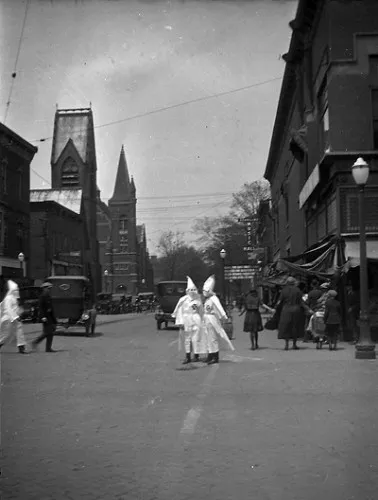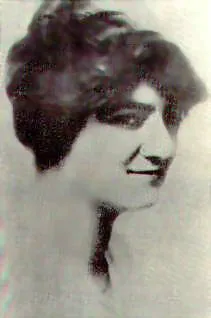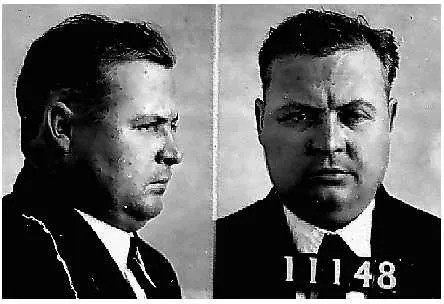“Murder Wasn’t Very Pretty”: The Rise and Fall of D.C. Stephenson
The Grand Dragon of the Klan and prominent Indiana politician had a vicious streak that had horrifying consequences
/https://tf-cmsv2-smithsonianmag-media.s3.amazonaws.com/filer/437px-D._C._Stephenson_Grand_Dragon_of_the_Klu_Klux_Klan_in_Indiana_c_1922-web.jpg)
On March 16, 1925, in the muted morning light of a hotel room in Hammond, Indiana, 29-year-old Madge Oberholtzer reached into the pocket of the man sleeping next to her. She found the grip of his revolver and slid it out, inch by inch, praying he wouldn’t stir. The man was D.C. Stephenson, political power broker and Grand Dragon of the Ku Klux Klan in 23 Northern states. With shaking hands she aimed the gun between his closed eyes. What passed for a lucid thought came to mind: She would disgrace her family if she were to commit murder; instead, she would kill herself.
She crept into an adjoining room and faced a full-length mirror. Beneath her dress chunks of her were missing. Bite marks covered her face, neck, breasts, back, legs and ankles, a macabre pattern of polka dots etched along her skin. She was bleeding from the mouth; he had even chewed her tongue. Her hand was steadier this time, lifting the gun to her temple, when she heard a step outside the door and the squeak of a turning knob. It was one of Stephenson’s associates. She buried the gun into the fold of her dress and slipped it back into the sleeping man’s pocket. She would find another way to kill herself, if he didn’t kill her first.
It was the beginning of the end, in different ways, for both Madge Oberholtzer and D.C. Stephenson, although the politician had long believed himself infallible. “I am the law in Indiana,” he famously declared, and with reason. At age 33, Stephenson was one of the most powerful men in the state, having controlled the governor’s election and the movements of several state legislators, influencing bills on nutrition, steam pollution, fire insurance, highways and even oleomargarine, all of which would line his pockets with graft. His hand-picked candidate for mayor of Indianapolis seemed certain to win election, and Stephenson himself dreamed of running for the U.S. Senate, even president.
Stephenson’s political success was directly tied to his leadership within the Klan, which by 1925 had a quarter-million members in Indiana alone, accounting for more than 30 percent of the state’s white male population. At the height of its popularity, the Klan was a mainstream organization whose roster included lawyers, doctors, college professors, ministers and politicians at every level, most of them middle- and upper-middle-class white Protestants who performed community service and supported Prohibition. The Klan exploited nativist fears of foreign ethnic groups and religions, Catholicism in particular. (Prejudice against African-Americans was not as much of a motivating factor to join the Klan in Indiana as it was in the South.) “Out in Indiana everybody seems to belong,” reported the New York Times in 1923. “Easterners have been surprised at the ready conquest by the Klan of a state which seemed of all our forty-eight the least imperiled by any kind of menace.”
The rise of Davis Curtis Stephenson seemed equally perplexing, especially since no one—not even those who professed to be his closest friends—knew much about him. “I’m a nobody from nowhere, really—but I’ve got the biggest brains,” he boasted. “I’m going to be the biggest man in the United States!” Stephenson told them his father was a wealthy businessman from South Bend who had sent him to college, but he quit to work in the coal business in Evansville, in the southwest tip of the state. When America entered World War I war in 1917, Stephenson said, he volunteered for the Army and was decorated for fighting the Germans in France. Upon his return, he learned that he was a millionaire; stocks he had purchased before the war had skyrocketed in value. He did well wholesaling coal and running an automobile-accessory business, and joined the Klan in 1921. Knights in Atlanta were impressed with his leadership ability and appointed him to head the organization in the Hoosier State.
In reality, Stephenson was born in 1891 in Houston, Texas, the son of a sharecropper. The family moved to Maysville, Oklahoma, where he attended school in a Methodist Church. He was an avid reader, especially interested in politics and history, and graduated from the eighth grade at age 16. That was the end of his formal education. He got a job with a Socialist newspaper and studied the party’s leaders, particularly Oscar Ameringer, who would go on to advocate for African-American enfranchisement and help elect an anti-Klan governor. Stephenson admired Ameringer’s style, the way he sold his politics as if he were a vaudeville pitchman, and he would later implement the Socialist’s techniques at rallies for the Klan.
In 1915, the blond, blue-eyed Stephenson courted a local girl named Nettie Hamilton, placing her picture in the newspaper under the headline: “THE MOST BEAUTIFUL GIRL IN OKLAHOMA.” They married and moved to Madill, where he worked at the local newspaper. But Stephenson, in what would become a pattern, got into a fight with his publisher after a bout of drinking and lost his job. He abandoned his pregnant wife and drifted to Cushing. In 1917, Nettie tracked him down and filed for a divorce, after which Stephenson volunteered for the Army. Instead of fighting bravely on the battlefields of Europe, as he liked to boast, he was sent to Boone, Iowa, to work as a recruiter. After the war he took a job as a traveling salesman, and in Akron, Ohio, met his next wife, Violet Carroll. The couple moved to Evansville, Indiana, where Stephenson worked as a stock salesman for the Citizens Coal Company, and where a newly revitalized Ku Klux Klan was taking root.

Despite his intensely private nature—“It’s no one’s business where I was born or who my folks were,” he once snapped—Stephenson made friends easily, developing a gregarious, slap-shoulder bonhomie, careful to never patronize or condescend. Despite his limited education, his speech was fluent and polished. When a local Klan organizer asked him to get involved, Stephenson initially demurred. “They kept after me,” he told the New York World, “and explained to me than the Klan was not an organization which took Negroes out, cut off their noses, and threw them into the fire.… I was told that the Klan was a strictly patriotic organization.… They finally convinced me the Klan was a good thing and I joined.”
As Stephenson’s career took off his marriage began to flounder. He drank heavily and succumbed to wild rages, once blackening his wife’s eye and another time scratching her face and kicking her. After their divorce in 1922, Stephenson began dating his 22-year-old secretary, frequently bringing her on work trips to Ohio, where he was establishing new offices for the Klan. During one such excursion the couple was parked in Stephenson’s Cadillac, lights off, on a country road in the outskirts of Columbus. Deputy Sheriff Charles M. Hoff stopped to investigate. “What are you doing there with your pants unbuttoned?” he asked.
Stephenson grabbed the girl’s left hand and thrust it toward the window.
“My God, would you insult this girl?” he said. “Did you see that ring, that diamond ring? I am going to marry this girl; we are engaged.” He added that he was “an official” and “couldn’t afford to have all this notoriety and publicity.” He pleaded guilty to a parking citation and indecent exposure.
Stephenson soon had another brush with notoriety. Joseph Cleary, a security officer for the Deschler Hotel in Columbus, was called to check on a report of a disturbance in Stephenson’s room on the upper floor. Cleary found a shattered mirror, smashed chairs, empty bottles of booze strewn about the floor. The hotel’s manicurist reported that when she arrived for Stephenson’s appointment, “there were three full quarts of whiskey and when I told him that I didn’t want any, he came over and grabbed me. He said that he would give me a hundred dollars if I would allow him to have intercourse with me. Of course, he was more rude than I care to be in expressing it… I told him that I was not in the habit of being insulted by anyone like that, and he said… ‘You will or I’ll kill you.’” She fled and ran into two of his associates outside, who tried to console her. “Don’t pay any attention to him,” one said. “He is a good fellow; he is drunk; he is all right when he is sober. You go downstairs and don’t bother about it.”

Stephenson met Madge Oberholtzer on January 12, 1925, at the inauguration gala for Governor Ed Jackson, who, with Stephenson’s help, had earned a reputation as the candidate most loathed by the “papists.” She was there at the invitation of a member of the inaugural committee, and busied herself making name tags and running errands. During dinner she sat across from Stephenson, who inquired about her background with flattering persistence.
She grew up in Indianapolis, where her father worked as a postal clerk and her family belonged to the Irvington Methodist Church. She was, a friend would later say, “an independent soul, yet timid. I don’t think anybody disliked Madge, but she didn’t make a great effort to make people like her, either.” She studied English, mathematics, zoology and logic at Butler College in Irvington, but dropped out, without explanation, at the end of her junior year. Currently she was the manager of the Indiana Young People’s Reading Circle, a special section of the Indiana Department of Public Instruction. She’d heard the rumors, though, that the Reading Circle program—and her job—were about to be eliminated due to budget cuts. She was 28 years old and still living with her parents. Stephenson asked her to dance.
The two began seeing each other frequently. She acted as his aide during the 1925 session of the General Assembly, carrying messages from his office down to his friends, and helped him write a nutrition book, One Hundred Years of Health. Using her Reading Circle connections, she planned to help sell the books to schools throughout the state.
Around 10 p.m. on March 15, 1925, Oberholtzer returned home from an evening with a friend. Her mother told her that Stephenson’s secretary had called and said he was leaving for Chicago and needed to see her at once. Oberholtzer changed into a black velvet dress and was met at her front door by one of Stephenson’s bodyguards. Eight hours later, her mother was on the phone with lawyer Ada J. Smith, frantic that Madge had never come home.
Two days later, while her parents were conferring with Smith at his office, a car pulled up outside the Oberholtzer home. Eunice Schultz, a boarder, heard someone groaning and saw Oberholzer being carried upstairs by a large man, who said the girl had been hurt in a car accident. Schultz called the family doctor, John Kingsbury, who hurried to Oberholzer’s bedside. “She was in a state of shock,” Kingsbury later recalled. “Her body was cold.” She told him that she didn’t expect, or want, to get well—that she wanted to die. He pressed her until she told him the whole story.

When she’d arrived at Stephenson’s, she said, she realized that he was drunker than she’d ever seen him. He forced her to start drinking and ordered her to accompany him to Chicago. Someone shoved her into a car, drove her to Union Station, and dragged her onto a train, where she was pushed into a lower berth in a private compartment with Stephenson. She was “bitten, chewed and pummeled,” she said. They never reached Chicago, stopping at Hammond, Indiana, where they checked into a hotel. She was lowered onto a bed next to Stephenson, who soon fell asleep.
Later that morning, she asked him for money to buy a hat and some makeup. Instead, she went to a drugstore and bought a box of mercury bichloride tablets. Back at the hotel, she intended to take the entire box but could choke down only three. When Stephenson discovered what she had done, he panicked and ordered his driver to take them back to Indianapolis. He forced her to drink ginger ale and milk, which she vomited all over the inside of the car. He worried she might die in the back seat. All the while she cried and screamed and begged to be thrown from the car and left on the side of the road. “You will stay right here until you marry me,” she recalled him saying. “You must forget this, what is done has been done, I am the law and the power.”
She died on April 14, nearly a month later, with her parents and nurse by her bedside. The official cause was mercury poisoning. Marion County prosecutor William Remy—one of the few officials Stephenson could not control—had him charged with rape, kidnapping, conspiracy and second-degree murder. His former political cronies, including Governor Jackson, swiftly abandoned him, and the Indiana Kourier called him an “enemy of the order.” Stephenson’s lawyers argued that Klan forces loyal to a political rival had set him up and questioned whether he could be held responsible for what was ultimately a suicide. “If this so-called dying declaration declares anything, it is a dying declaration of suicide, not homicide,” defense attorney Ephraim Inman said. “… Has everybody lost his head? Pray, are we all insane?”
The citizens of Indiana also expressed some skepticism about Oberholzer’s deathbed statement. “That was a gruesome trial,” one woman recalled. “This girl might have been a party girl, I supposed she was or she wouldn’t have been on that train, but even back in those days you know, murder wasn’t very pretty.” On November 14, 1925, Stephenson was convicted and sentenced to life imprisonment. By 1928, the Indiana Klan, once the strongest in the Invisible Empire, had collapsed, with membership totaling only 4,000, down from a high of half a million. Stephenson was paroled in 1950 on the condition that he take a job in Illinois and settle in that state. Instead he went to Minnesota, where he was arrested and sent back to prison in Indiana. Six years later he was discharged by Governor George Craig, who reasoned, “I don’t see why Stephenson won’t be able to cope with life. He’s mentally all right.”
Stephenson moved to Seymour, Indiana, where he married his third wife, Martha Dickinson. They separated in 1962, after Stephenson was arrested and accused of trying to force a 16-year-old girl into his car. The judge issued a $300 fine, which Stephenson paid out of pocket. Next he wandered to Jonesboro, Tennessee, where he met a widowed Sunday school teacher named Martha Murray Sutton. She was 55; he was 74. They wed, although he had never officially divorced the previous Martha. He suffered a heart attack on June 28, 1966, while bringing her a basket of fruit. She held him as he died. ”I knew nothing of his background,” his widow said. “Except that I loved him very much and we were married. He was a very wonderful person.”
Sources:
Books:
M. William Lutholtz, Grand Dragon: D.C. Stephenson and the Ku Klux Klan in Indiana. West Lafayette, IN: Purdue University Press, 1991; Richard K. Tucker, The Dragon and the Cross: The Rise and Fall of the Ku Klux Klan in Middle America. Hamden, CT: The Shoe String Press, 1991; David H. Bennett: The Party of Fear: From Nativist Movements to the New Right in American History. Chapel Hill: University of North Carolina Press, 1988.
Articles:
“Stephenson Fights Murder Testimony.” New York Times, November 6, 1925; “Indiana Swayed Entirely By Klan.” New York Times, November 7, 1923; “Holds Ex-Klansman on Assault Charge.” New York Times, April 4, 1925; “Stephenson Held for Death of Girl.” New York Times, April 21, 1925; “Finds Ex-Klan Head Murdered Woman.” New York Times, November 15, 1925.
/https://tf-cmsv2-smithsonianmag-media.s3.amazonaws.com/accounts/headshot/karen-abbot-240.jpg)
/https://tf-cmsv2-smithsonianmag-media.s3.amazonaws.com/accounts/headshot/karen-abbot-240.jpg)